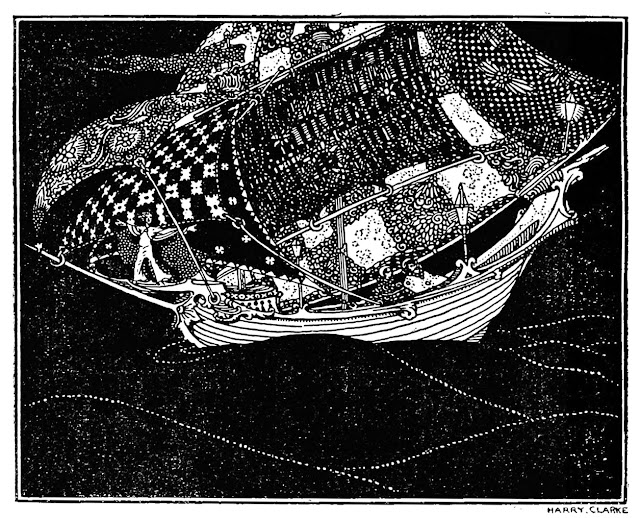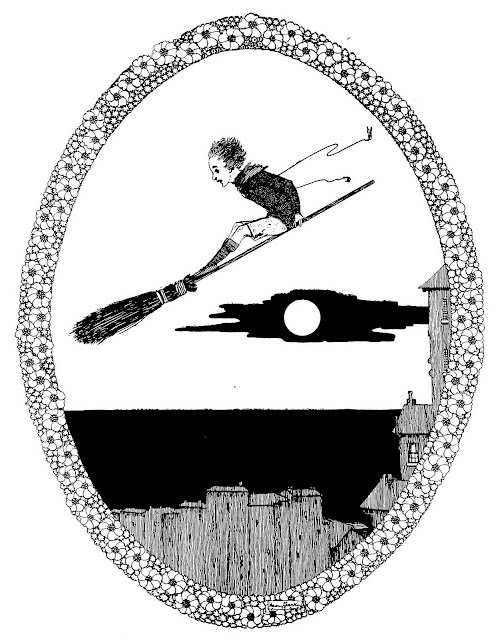I did find a capsule review of the The Romance of Tristram and Iseult, published October 8th, 1910, in the New York Times, under the heading, Philadelphia Book News, with the following text:
PHILADELPHIA, Oct. 7. -- Next Monday has been fixed for the issue by the J. B. Lippincott Co. of a sumptuous edition of "The Romance of Tristram and Iseult," translated from the French of Joseph Bedier by Florence Simmonds. This promises to be one of the most beautiful of the gift books of the season, the distinguishing characteristic of this edition being the thirty-two remarkable colored illustrations by Maurice Lalau.
The scary part is that the review states there are 32 illustrations, and the edition found at archive dot org, only has 20 remarkable color illustrations. If there are an additional 12, I dearly want to see them.
Click the link to view these amazing illustrations in their original context at archive dot org. The Romance of Tristram and Iseult was published by William Heinemann out of London, and by J. B. Lippincott out of Philadelphia, in 1910. William Heinemann is the same publisher who published much of Arthur Rackham's best known work.
It is a wonder more attention has not been paid to this illustrator. When I view the larger body of Lalau's available art and illustrations, I see parallels to the line work and drama of Arthur Rackham, including his droll sense of humor; and the composition and colors of Edmund Dulac. I strongly suspect and propose Maurice Lalau's influence, or perhaps he was influenced by them; and if I were ever to earn an advanced degree in art history, I would explore this potential connection.
If anyone has knowledge of Maurice Lalau, please share your information in comments, and add any links. Here are a few bits of information I've come across, here, here, and here, and here.
What I love about these illustrations is the rich color, and fully realized world, the room interiors and building exteriors executed in loving detail, including trunks and tapestries, musical instruments, books, looms, clothing, games, utensils, and a child's toys; and the drama of every scene, where every figure is a personality, major or minor, with an integral role; and the balance of indoor and outdoor presentations, and the depictions of sunset, daytime and moonlight. I can only imagine the artist immersed himself in historical description and visual references, and made numerous preliminary sketches.
I copied these illustrations at the highest possible resolution, and worked with the brightness and contrast to lighten them just a touch to bring out the detail, while retaining the original color tones and balance. The original scans are exceptionally good.
Click on each image for great detail.
 |
| Maurice Lalau ~ The Romance of Tristram and Iseult ~ 1908 Translated from the French by Florence Simmonds London: William Heinemann, c1910 Frontispiece: Tristram and Iseult |
 |
| Maurice Lalau ~ The Romance of Tristram and Iseult ~ 1909 Translated from the French by Florence Simmonds London: William Heinemann, c1910 Tristram spurred his horse against him with such fury... |
 |
| Maurice Lalau ~ The Romance of Tristram and Iseult ~ 1909 Translated from the French by Florence Simmonds London: William Heinemann, c1910 The lovers lived crouching in the hollow of a rock... |
 |
| Maurice Lalau ~ The Romance of Tristram and Iseult ~ 1909 Translated from the French by Florence Simmonds London: William Heinemann, c1910 She stretched out her arms on either side, the palms open. |
 |
| Maurice Lalau ~ The Romance of Tristram and Iseult ~ 1909 Translated from the French by Florence Simmonds London: William Heinemann, c1910 Under the trees he pressed her to his heart without a word. |
 |
| Maurice Lalau ~ The Romance of Tristram and Iseult ~ 1909 Translated from the French by Florence Simmonds London: William Heinemann, c1910 The Queen sings sweetly. |
 |
| Maurice Lalau ~ The Romance of Tristram and Iseult ~ 1909 Translated from the French by Florence Simmonds London: William Heinemann, c1910 King Mark and Iseult the Fair were seated at chess. |
 |
| Maurice Lalau ~ The Romance of Tristram and Iseult ~ 1908 Translated from the French by Florence Simmonds London: William Heinemann, c1910 Tristram disguised himself as a beggar. |
 |
| Maurice Lalau ~ The Romance of Tristram and Iseult ~ 1909 Translated from the French by Florence Simmonds London: William Heinemann, c1910 She gave up the ghost and died beside him for grief. |
 |
| Maurice Lalau ~ The Romance of Tristram and Iseult ~ 1910 Translated from the French by Florence Simmonds London: William Heinemann, c1910 Title Page |


























































